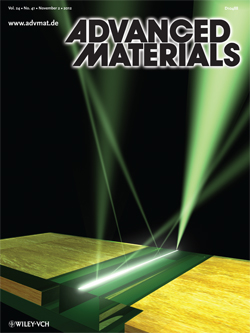CHESS X-rays help characterize organic transistors

Plastic electronics, in which an organic material replaces silicon, hold promise for low-cost, flexible electronics. But understanding and controlling these materials' microstructures is an ongoing challenge.
With the help of the D1 X-ray beamline at the Cornell High Energy Synchrotron Source (CHESS), scientists have come many steps closer to designing the perfect organic semiconductor by spatially mapping the microstructure, texture, grain sizes and grain orientations of organic semiconductor thin films.
Detlef Smilgies, senior research associate at CHESS, is co-author of an article in the Nov. 2 issue of the journal Advanced Materials (Vol. 24, No. 41), featured on the journal's cover, that describes this direct structural mapping.
The study's senior author, Aram Amassian of King Abdullah University of Science and Technology (KAUST), is a former Cornell postdoctoral associate, and the first author, Amassian's research associate Ruipeng Li, is a former visiting graduate student at CHESS; both are frequent Cornell synchrotron users.
The performance of a transistor is usually described by the mobility of its charge carriers -- the quicker the charge carriers can move through the material, the better. Charge mobility can be hampered by grain boundaries, which are the interfaces of individual grains in a crystal, either because they are misaligned or growing on different planes.
These interfaces play an important role in the texture of the crystalline organic material. A basic transistor typically has a source, where charge carriers enter; a drain, where the charge carriers exit; and a gate in the middle, which regulates the mobility of the charge carriers. In the most common architecture, the organic semiconductor is printed on a substrate pre-patterned with source and drain electrodes. The organic layer can thus form different growth planes on different parts of the substrate, and it's hard to tell fundamentally which growth planes are best to carry charges.
To shed some light on this question, the researchers used a technique called microbeam grazing incidence wide-angle X-ray scattering to probe how the organic transistor's molecular structure changed within the gate channel of the transistor, i.e., between the source and the drain electrodes. The microbeam at CHESS D1 station was obtained with an X-ray-focusing capillary -- an optical device that helps narrow the X-ray beam -- only 10 microns wide or one-fifth the width of a human hair.
This microbeam intercepted the transistors at a low angle of 2 degrees; the resulting wide-angle scattered X-rays were collected with a high-resolution camera. The scientists found that a particular growth plane that formed on the gold electrode extended up to tens of microns into the channel. Then a mix of planes occurred in the center of the channel.
When the channel width was below 20 microns, a favorable orientation prevailed, and the devices had good performance, while wider channels with mixed structures performed more poorly, with lower carrier mobility.
A chemical modification of the electrode surfaces with a fluorinated self-assembled monolayer was found to promote the formation of the favorable growth plane, which extended well into the channel. In some cases this growth plane bridged the channel entirely, significantly reducing the bottlenecks to charge transport of the untreated device.
Smilgies developed the instrumentation used in the experiment and helped with calibration and characterization of the microbeam used in the study. D1, he noted, is especially suited for in-situ studies of soft materials -- techniques that Smilgies has developed over the past 12 years at CHESS.
Oana Jurchescu and her student Jeremy Ward at Wake Forest University supplied the devices; John Anthony and Marcia Payne at the University of Kentucky provided the molecular material. CHESS is supported by the National Science Foundation and National Institutes of Health. The study was also supported by the KAUST Office of Competitive Research Funds, which funds part of the D1 beamline instrumentation.
Media Contact
Get Cornell news delivered right to your inbox.
Subscribe